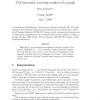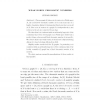316 search results - page 1 / 64 » The chromatic covering number of a graph |
JGT
2006
13 years 4 months ago
2006
Following [1], we investigate the problem of covering a graph G with induced subgraphs G1, . . . , Gk of possibly smaller chromatic number, but such that for every vertex u of G, ...
COMBINATORICS
2006
13 years 4 months ago
2006
Two sets are non-crossing if they are disjoint or one contains the other. The noncrossing graph NCn is the graph whose vertex set is the set of nonempty subsets of [n] = {1, . . ....
DM
1998
13 years 4 months ago
1998
We characterize the edge-signed graphs in which every 'significant' positive closed walk (or combination of walks) has even length, under seven different criteria for si...
MLQ
2011
12 years 11 months ago
2011
Given a graph G whose set of vertices is a Polish space X, the weak Borel chromatic number of G is the least size of a family of pairwise disjoint G-independent Borel sets that cov...
ARSCOM
2004
13 years 4 months ago
2004
The concept of circular chromatic number of graphs was introduced by Vince(1988). In this paper we define circular chromatic number of uniform hypergraphs and study their basic pr...


